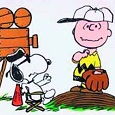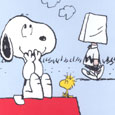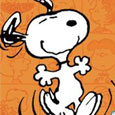United Features Syndicate/Lee Mendelson Films/Cinema Center 100 Productions (1969, 1972), CBS DVD/Paramount Home Entertainment (March 15, 2011), 2 discs, 166 mins, 1.85:1 anamorphic widescreen, Dolby Digital 5.1 and 2.0, Rated G, Retail: $16.99
Storyboard:
Charlie Brown stars in his first two features. First, he competes in a national spelling bee, and seems poised to achieve glory prior to a typical Charlie Brown moment. Then, he faces the prospect of losing his dog to a previous owner.
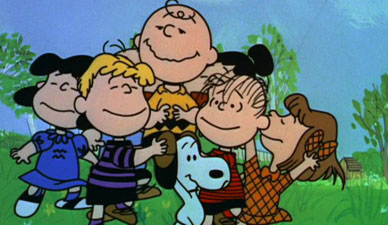
The Sweatbox Review:
Now this was a surprise. I had thought that Warner owned the rights to everything Peanuts that was ever animated, but I’d forgotten that the theatrical films were not part of that deal. That is a real shame, because while Warner has been fairly aggressive in bringing the TV specials to DVD, Paramount has been extremely lame in their handling of the films. They released two bare-bones DVD releases, for the first two films, in 2006; and the final two films have never come to DVD at all. Now, five years later, Paramount comes out with a two-disc double feature of Peanuts films— featuring the exact same discs they already released. Yay.

A Boy Named Charlie Brown
The first of the Charlie Brown movies was A Boy Named Charlie Brown, premiering in time for Christmas of 1969. By this time, the first six television specials had aired, celebrating Christmas, baseball, Halloween, love, dog ownership, and summertime. The movie chose to examine a staple of Peanuts stories, Charlie Brown’s quest for self-assurance and acceptance by his peers. Those first few television specials were all classics, so one might expect to love the movie just as much. Unfortunately, it is a little too much like the TV specials, in that it too has about twenty minutes of good material; too bad the movie lasts almost an hour and a half!
The movie starts out similarly to many of the specials, appearing to be somewhat episodic although generally focusing on how much of a lovable loser ol’ Charlie Brown is. Eventually, a plot emerges, as Charlie Brown shows himself to be a pretty good speller at the school’s spelling bee. He wins his school’s competition, and basks for the first time in the adoration of his classmates. It is a moment that long-time Peanuts fans have to enjoy, as that stupid bald-headed kid finally got something right. Of course this couldn’t be a Charlie Brown story if it ended there. That would ruin the whole character, and he still had another few decades of comic strips and TV specials to be portrayed as a failure.
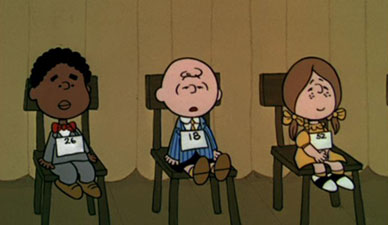
Soon, Charlie Brown finds out what everyone else apparently knew— winning the school competition is just the first step. Next is the National Elimination Spelling Bee! Self-doubt and desperation immediately come to the forefront again (now that’s the Charlie Brown we all know and love!). There can be little doubt that tragedy will follow, and the fun comes in seeing it unfold, and in seeing just how close Charlie Brown can get to victory before ultimately failing. The scenes of him competing in the state competition are classic, with a healthy dose of anticipation as to how he will ultimately screw up. And when the moment comes, it is perfect. As Linus and Snoopy watch from the audience, and the rest of the gang views the spelling bee on television, we all feel for good ol’ Charlie Brown.
Naturally, creator/writer Charles Schulz and his animation production team of Mendelson and Melendez make this story about more than just a kid failing for the umpteenth time. It is always a little heartbreaking to see Charlie Brown fall, but we are given comfort that it is okay to fail. Even though it may seem unfair that some of us fail more than others, failure is a part of life, and any one failure is unlikely to mark us for life. If Charlie Brown’s friends seem unfortunately cruel in their disdain, we all really know it is only because they secretly like and maybe even admire him just for trying. Charlie Brown is constantly putting himself out there, and repeatedly trying to accomplish tasks that have proven time and again to be beyond him, and yet he perseveres.

Now, that would all make for a pretty good TV special. The movie, however, is terribly padded with a number of musical numbers that often do nothing to advance or even recognize the story. Even that could be forgiven, if the direction and art styling were at all interesting, but they are decidedly not. I realize that with a property such as Peanuts, one does not wish to go overboard on making the visual style too splashy, but neither is it necessary to stage everything in the most boring way imaginable. And yet, much of the movie seems to do everything possible to remain non-animated. And I am not referring to the quality of the animation itself, which is generally satisfactory; I refer instead to a steadfastness in avoiding anything that takes advantage of the cartoon medium… or even the film medium, for that matter. (Actually, I should not be too quick to stick up for the animation. While the characters move well enough to suit the movie, this film features some of the most off-model Peanuts drawings that I’ve ever seen!)
When the film does try to do something more with the animation, it tends to be simply conceived video tricks… flashing squares, and some mildly interesting split-screen stuff. A montage that goes on while Schroeder plays a solo is at least ambitious in its effort to go with a totally different visual style, but falls short due to the artists over-reaching themselves. Even in standard scenes, the composition is often poorly done, with large patches of open space in the picture. It just looks like a slapdash production. Like Charlie Brown, the artists’ grip exceeded their grasp.

And yet, I cannot totally dismiss the film. As Charlie Brown’s big screen debut, it is somewhat historical. Also, the main storyline of the spelling bee is really among the best ever seen in Peanuts cartoons. The thing to do is to try to ignore the movie’s faults and keep your remote handy to pass over at least a couple of the musical numbers.
The DVD does do one major thing right. The DVD preserves the movie’s original runtime of 86 minutes, in contrast to the 79-minute cut shown previously on home video and in television syndication. After many years of missing out, this DVD allowed us to see Lucy giving Charlie Brown a replay of his missed football kick, a full telephone conversation between Charlie Brown and his hotel’s room service, and several scene extensions.
5/10

Snoopy Come Home
There are a lot of similarities between these two films. Snoopy Come home also has a thin plot and lots of padding, musical numbers that go nowhere, and bland styling. It was also directed by Bill Melendez, who proved competent in the TV specials, but here struggles to make the most of his million dollar budget for the movie. This film made only about a quarter of its budget initially, though TV airings and home video have made it profitable over the years. Many even consider this film the best of the four Peanuts movies, as this one has a strong streak of sentiment in it. It also has songs by the Sherman Brothers, legendary from other projects, particularly Disney films like Mary Poppins.
Snoopy Come home inexplicably begins with the neighborhood kids playing at the beach, revealed to apparently be in walking distance from Charlie Brown’s house. We get about two or three songs in before arriving at anything resembling a plot, though I did enjoy the peppy title song that plays with the opening credits (where we see Woodstock introduced to animation for the first time). That the credits almost immediately bring us to another song, At The Beach, seems an odd choice, and is indicative of the film’s over-reliance on songs that don’t advance the story.
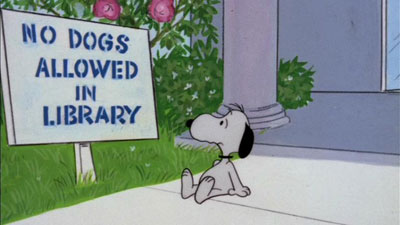
Nevertheless, we do soon see some friction between Snoopy and Charlie Brown, who sees his dog as becoming overly independent and prone to taking Charlie Brown for granted. Then, in another move that predicts what is to come, we get a reprise of At The Beach! We also get introduced to a major motif of the movie, one which gets its own song sung by classic baritone voice performer Thurl Ravenscroft, No Dogs Allowed. Snoopy gets kicked off the beach, out of the library, and away from Linus and his blanket, before getting into a boxing match with Lucy. And then… we are finally introduced to a major character: Lila.

Lila is a little girl recuperating from an unknown illness in the hospital. She writes Snoopy, who responds by saying good-bye to Charlie Brown, and takes Woodstock with him to visit the little girl. Poor Snoopy, though, is kicked off the bus (No Dogs Allowed again!), so he and Woodstock have to walk, embarking on a road trip that takes up much of the movie, and brings on more than a couple of rounds of the song Me And You. Meanwhile, Linus helps Charlie Brown figure out the identity of the mysterious Lila, who turns out to have briefly been Snoopy’s first owner (which floors Charlie Brown when he finds out).
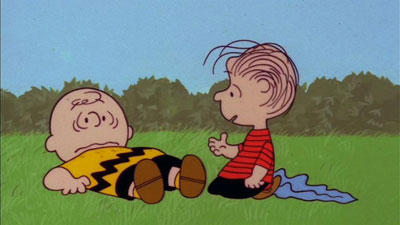
Snoopy gets sidetracked when he’s dognapped by an enthusiastic but awful girl, who insists on tying him up in her yard, bathing him, playing tea party (yes, with Snoopy in a dress!) and generally making him miserable. Snoopy escapes, and we get yet another reprise of Me And You as Snoopy and Woodstock head back to the woods. A sequence with Peppermint Patty taking Charlie Brown to the fair helps to break up the never-ending road trip, and then Snoopy finally gets to see Lila. There reunion is joyful, but with a third of the film to go, there’s one more twist: Lila wants Snoopy to go home with her when she’s released. Snoopy is reluctant to agree, but doesn’t wish to break the little girl’s heart. He proceeds to return home, just to say good-bye and settle his affairs. The kids are devastated, especially Charlie Brown, but they manage to hold a party for him. Lila is the only one really happy about all this, but it will take a final twist to allow everything to go back to normal, for better or worse.

Snoopy Come home is a great movie, if you use some judicious fast-forwarding. Like the previous film, there’s a great half-hour TV special lurking within the 80-minute runtime. The Sherman Bros. songs are actually kind of catchy if forgettable; they’re just over-utilized to pad things out. There is no doubting that the story in this movie delivers a good dollop of emotion; it’s just too bad it’s diluted by stretching it into feature length. I always preferred Race For Your Life, Charlie Brown, which I hope will be forthcoming now that the first two Charlie Brown films have each been released twice.
6/10
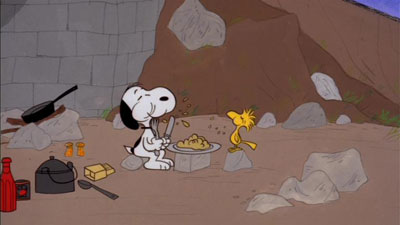
Is This Thing Loaded?
These discs were given no special features— not even advertisements— on their original releases, and the same is true here. It’s just sad, given what we’ve seen Warner do with their releases.
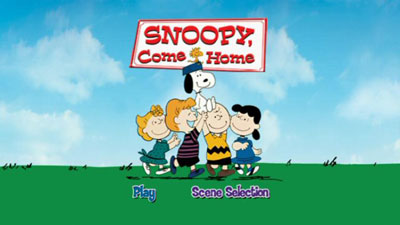
Case Study:
The two discs come in a clear keepcase with a swinging tray. Cover art reveals these to be identical to the previously released discs, complete with 2006 copyrights. There is no insert. And how about that ugly cover? While it’s nice to see them trying to get away from the split image seen on so many DVD double features lately, I can’t say I like the design on this at all. Charlie Brown’s head has been cut off, and the “Peanuts Double Feature” lettering seems to be awkwardly trying to replicate a smile, using boring black letters. Just yuck.
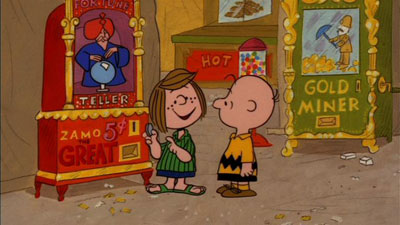
Ink And Paint:
The presentation of these films on DVD is pretty shameful. They are just ugly to look at. Absolutely no restoration appears to have been done, with numerous scratches, smudges, tears, dust particles, and the like. Granted, much was in the original negative in terms of what was apparently a messy camera process, but the state of the source material is pretty shoddy too. I was actually shocked at how bad these films looked, particularly A Boy Named Charlie Brown, which is dark and muddy.

Both films are matted to 1.85:1, seemingly cropped from the ratio of the original artwork. Snoopy Come Home’s opening credits are actually about 1.66:1, before the film goes to 1.85:1. Cropping gets a little tight on the top in some shots as a result, although the first film actually often seems cramped at one edge or another. Something’s up with this framing, and this is yet another reason for doing these movies up properly someday.

Scratch Tracks:
A Boy Named Charlie Brown received an upgrade to a 5.1 Dolby Digital soundtrack, but expectations should be appropriately managed. The 5.1 track does fill things out slightly when compared to the also-included Stereo track. There’s no low end to speak of, of course, but the 5.1 track does manage to create a nice bit of ambience with the music, as well as a few well-placed sound effects. Snoopy Come Home gets a pretty drab stereo track, but it sounds clear enough.

Speaking of the music, I did find it bizarre to have to do without Vince Guiraldi’s music for so much of the first movie and all of the second. Frankly, it just doesn’t feel like a Peanuts cartoon if it has music that isn’t dominated by nifty piano jazz. And, it would have helped if the musical parts added more to the stories. Instead, several of them feel tacked-on, as if they were only put in because an animated film needs to have musical numbers. Beyond extraneous, the songs can be boring, especially in the fist film.
There are no other language tracks or subtitles offered.
Final Cut:
Either of these films would have made a dandy TV special, but stretching out their sparse stories into 80 minutes or so required a lot of songs (reused over and over again to almost comedic effect in Snoopy Come Home) and a number of scenes that contributed little to the narrative. Worse, in this 2-disc set CBS and Paramount have once again dumped onto us the same no-frills discs with lousy video that they gave us 5 years ago— with an even worse cover. Still, there are moments to love in each of these, and at just a couple dollars more than either previous release, this new collection is the best way out there to collect these two movies. Keep the fast-forward button handy, and you might just enjoy these. Personally, I’m looking forward to the final two Peanuts films being released to DVD, as they are well past overdue.
 | ||
 |








